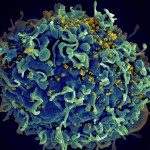Présentation
A large proportion of the emerging viral pathogens that have affected humans in the last decades are purported to have originated from various animal species. Human infection by simian foamy viruses (SFVs) is a unique and natural model for the study of the restriction of the emergence of retroviruses in humans. In PTR 437, our major goal was to investigate the physiopathology of, and the immune response to, SFV infection in humans.
Through the study of donors infected with or exposed to SFVs and living in Cameroon and Gabon, we showed that:
- The SFV-infected individuals had significantly lower hemoglobin concentrations and hematocrits, and tended to be have lower CD4 T-lymphocyte percentages and higher plasma IL-6 concentrations than uninfected controls;
- SFVs have co-speciated with their nonhuman primate (NHP) hosts for at least 30 million years and SFVs from different host species form monophyletic groups. We demonstrated a notable exception to the established phylogeny in the env gene, for which two genotypes are infecting the SFV-infected hunters we studied, as well as NHP from the same geographic localization. In the Env protein, the region of highest variability corresponds to the receptor binding domain.
- Neutralizing activity was detected in the plasma of > 90% of SFV-infected donors. Titers ranged from 1:22 to 1:14724. Patients with broader responses had higher blood viral load. Two-thirds of donors recognized only the isolate from the same genotype as their own virus. One third of donors recognized the two genotypes. We had indirect evidence of co-infection by two SFV strains for some of them.





